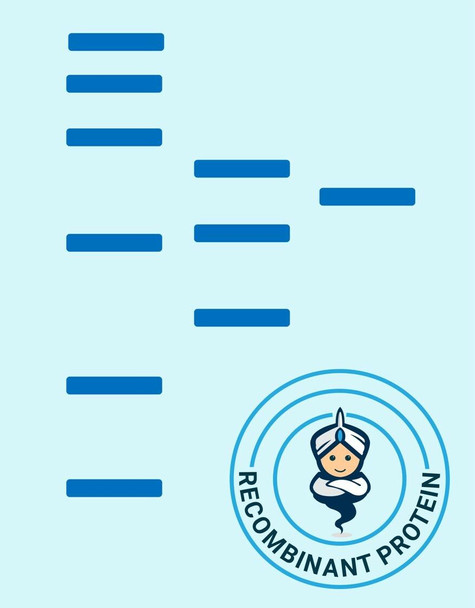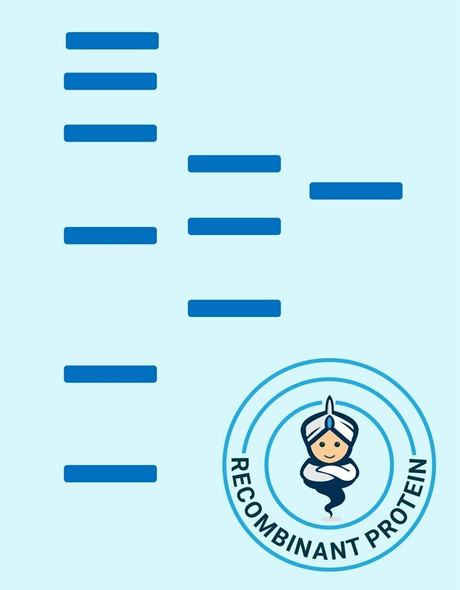Human PIP Protein Recombinant Protein (RPPB0886)
- SKU:
- RPPB0886
- Product type:
- Recombinant Protein
- Size:
- 20ug
- Species:
- Human
- Target:
- PIP Protein
- Synonyms:
- Prolactin-inducible protein
- Gross cystic disease fluid protein 15
- GCDFP-15
- Prolactin-induced protein
- Source:
- Escherichia Coli
- Uniprot:
- P12273
Description
| Product Name: | Human PIP Protein Recombinant Protein |
| Product Code: | RPPB0886 |
| Size: | 20µg |
| Species: | Human |
| Target: | PIP Protein |
| Synonyms: | Prolactin-inducible protein, Gross cystic disease fluid protein 15, GCDFP-15, Prolactin-induced protein, Secretory actin-binding protein, SABP, gp17, GCDFP15, GPIP4, PIP. |
| Source: | Escherichia Coli |
| Physical Appearance: | Sterile Filtered clear solution. |
| Formulation: | PIP protein solution (1mg/ml) contains 20mM Tris-HCl buffer, (pH 8.0), 10% glycerol and 0.4M Urea. |
| Stability: | Store at 4°C if entire vial will be used within 2-4 weeks. Store, frozen at -20°C for longer periods of time. For long term storage it is recommended to add a carrier protein (0.1% HSA or BSA).Avoid multiple freeze-thaw cycles. |
| Purity: | Greater than 90% as determined by SDS-PAGE. |
| Amino Acid Sequence: | MGSSHHHHHH SSGLVPRGSH MGSQDNTRKI IIKNFDIPKS VRPNDEVTAV LAVQTELKEC MVVKTYLISS IPLQGAFNYK YTACLCDDNP KTFYWDFYTN RTVQIAAVVD VIRELGICPD DAAVIPIKNN RFYTIEILKV E |
Prolactin-inducible protein (PIP) is a main protein component of benign breast gross cysts. PIP is a famous indicator of breast cancer, since it is found in around 50% of all breast cancer specimens. PIP is expressed in exocrine glands, in pathologic conditions, in breast cysts and breast cancers exhibiting apocrine features. PIP and prostate specific antigen are co-expressed in androgen receptor-positive breast tumours.
PIP Human Recombinant produced in E.Coli is a single, non-glycosylated polypeptide chain containing 141 amino acids (29-146 a.a.) and having a molecular mass of 15.9kDa.PIP is fused to a 23 amino acid His-tag at N-terminus & purified by proprietary chromatographic techniques.
| UniProt Protein Function: | PIP: Belongs to the PIP family. |
| UniProt Protein Details: | Protein type:Secreted, signal peptide; Cytoskeletal; Secreted Chromosomal Location of Human Ortholog: 7q34 Cellular Component: extracellular region; extracellular space; nucleus Molecular Function:aspartic-type endopeptidase activity; glycoprotein binding; IgG binding; protein binding; protein dimerization activity Biological Process: detection of chemical stimulus involved in sensory perception of bitter taste; proteolysis; retinal homeostasis; transmembrane transport |
| UniProt Code: | P12273 |
| NCBI GenInfo Identifier: | 134170 |
| NCBI Gene ID: | 5304 |
| NCBI Accession: | P12273.1 |
| UniProt Secondary Accession: | P12273,A0A963, A0A9C3, A0A9F3, A4D2I1, |
| UniProt Related Accession: | P12273 |
| Molecular Weight: | 16,572 Da |
| NCBI Full Name: | Prolactin-inducible protein |
| NCBI Synonym Full Names: | prolactin induced protein |
| NCBI Official Symbol: | PIP |
| NCBI Official Synonym Symbols: | GPIP4; GCDFP15; GCDFP-15 |
| NCBI Protein Information: | prolactin-inducible protein |
| UniProt Protein Name: | Prolactin-inducible protein |
| UniProt Synonym Protein Names: | Gross cystic disease fluid protein 15; GCDFP-15; Prolactin-induced protein; Secretory actin-binding protein; SABP; gp17 |
| Protein Family: | Proline iminopeptidase |
| UniProt Gene Name: | PIP |
| UniProt Entry Name: | PIP_HUMAN |










